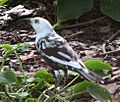Leucism facts for kids

Leucism is a special condition where an animal has less color than usual. This makes their skin, hair, feathers, or scales look white, very pale, or patchy. But here's the cool part: their eyes stay the normal color!
Leucism is different from albinism. Albinism means an animal is missing a specific color called melanin. But with leucism, the animal has less of many different types of colors, not just melanin.
Contents
What is Leucism?
Leucism happens when an animal's body doesn't make enough pigment. Pigments are the natural colors found in living things. Think of them like tiny paint particles that give animals their unique look. When an animal has leucism, these pigment cells don't develop properly or don't work as well as they should.
How is Leucism Different from Albinism?
It's easy to mix up leucism and albinism because both can make animals look white. But there's a key difference:
- Leucism: Animals with leucism have a reduced amount of all types of pigments. Their eyes usually stay their normal color, like blue, brown, or green. This is because the cells that make eye pigment are often not affected.
- Albinism: Animals with albinism are missing only the pigment called melanin. Melanin is responsible for dark colors like black, brown, and some reds. Because melanin is missing everywhere, albino animals often have red or pink eyes. This is because you can see the blood vessels behind their clear irises.
So, if you see a white animal with normal-colored eyes, it's likely leucistic. If it has red or pink eyes, it's probably albino.
Animals with Leucism
Leucism can happen in many different kinds of animals. You might see leucistic birds, mammals, reptiles, and even fish. It's a genetic condition, meaning it's passed down through an animal's genes.
Why Do Animals Get Leucism?
Leucism is caused by a change in an animal's genes. These changes affect how pigment cells develop or move around in the body. Sometimes, it's a recessive gene, meaning an animal needs to inherit two copies of the changed gene (one from each parent) to show the condition. Other times, it can be a dominant gene.
Animals with leucism are not necessarily unhealthy. They can live normal lives, but their pale coloring might make them stand out more to predators or make it harder for them to hide.
Images for kids
-
This white horse owes its coloring to a dominant allele (dominant white).
-
A leucistic rock pigeon. Both the eyes and legs are still of the normal colour.
-
Leucistic Texas rat snake (Elaphe obsoleta)
-
Leucistic common grackle (Quiscalus quiscula)
-
Leucistic Indian peacock (Pavo cristatus)
 In Spanish: Leucismo para niños
In Spanish: Leucismo para niños






